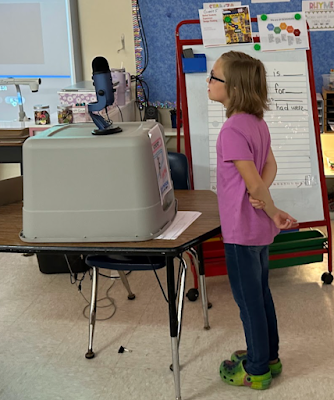Listen to this Create Make Learn podcast series created in collaboration with Ms. Kathy Fechter and students from Bethel Elementary School
Bethel Elementary Students
Design Thinking Podcast
Show Notes / Blog Post
When you think about STEAM projects in school, it's easy to imagine Science, Technology, Engineering and Mathematics; and in many STEAM projects, you'll find Art in the Mix. But at Bethel Elementary School, ELA teacher, Ms. Kathy Fechter, and her students used their STEAM projects to practice and grow proficiency in skills from their Language Arts curriculum.
Ms. Fechter was introduced to the Stanford d.school Design Thinking Process at Create Make Learn Summer Institute and knew she wanted to teach her students how to use design thinking to become proficient with creative and practical problem solving one of 5 Transferable Skills from the Vermont Agency of Education).
In the next stage of Design Thinking, Bethel students used cardboard, tape, and recyclables to create a Prototype for an invention that would meet the needs of their user.
Listen to the first two episode of their podcast here, and stay tuned for more episodes next week along with more information about how we collaborated to create the podcast.
Bethel Elementary Students
Design Thinking Podcast
Can you identify the Vermont Transferrable Skills thatthese Bethel Elementary students practiced during their project?
(More info: Transferable Skills | Vermont Agency of Education).
- I can demonstrate organized and purposeful communication.
- Use evidence and logic appropriately in communication.
- Integrate information gathered from active speaking and listening.
- Adjust communication based on the audience, context, and purpose.
- Demonstrate effective expressions and receptive communication, including oral, written, multi-media, and performance.
- Use technology to further enhance and disseminate communication.
- Collaborate effectively and respectfully.
- Observe and evaluate situations in order to define problems.
- Frame questions, make predictions, and design data collection and analysis strategies.
- Identify patterns, trends, and relationships that apply to solutions.
- Analyze, evaluate, and synthesize evidence, arguments, claims, and beliefs.
- Generate a variety of solutions, use evidence to build a case for best responses, critically evaluate the effectiveness of responses, and repeat that process to generate alternate solutions.
- Identify opportunities for innovation and collaboration.
- Use a range of tools, including technology, to solve problems.
- Persist in solving challenging problems and learn from failure.










.png)
